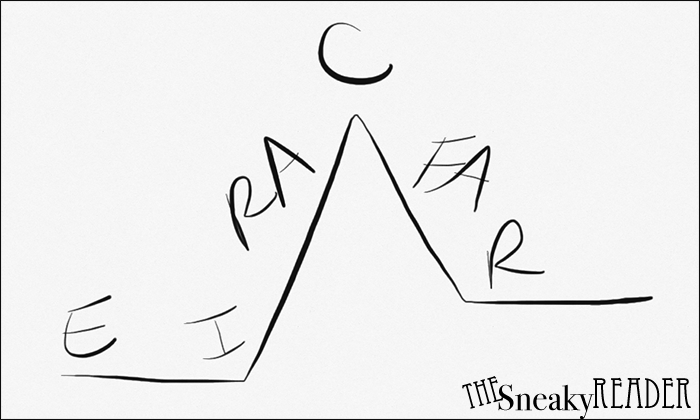I've been dealing with every teacher's worst nightmare: a prolonged leave of absence. After an unexpected illness had me benched for almost two weeks, I was devastated that my honors students were studying and performing Arthur Miller's The Crucible without me. Being a theater geek myself, drama is one of my favorite things to teach in the entire world, and sitting at home trying to rest while I knew my students were studying the play without me was tantamount to sucking on under-ripe lemons while cleaning baseboards with a Q-tip.
 |
| Have I mentioned how awesome my students are? Here's one of my ridiculously creative get-well presents from an eleventh grader. |
Luckily, I managed to secure a fantastic substitute, but I was still worried about how I would manage to review two weeks' worth of learning in a single class period upon my return. In the dramatic form, characters take center stage (literally), so I decided to do a huge character carousel with a twist.
In this activity, which can take anywhere from 30-45 minutes, the students treat white boards as mirrors, drawing portraits of their assigned character that show how the character views him or herself. Students use symbols in the creation of their portrait to show the characters' values, beliefs, personality, motivations, and relationships. Once again, a great deal of analysis and interpretation goes into this activity, while students just feel like they're drawing a picture. Teacher win.
Lesson Objectives
Through this lesson, students will be able to:
- Analyze characterization and character motives, values, and beliefs
- Create working symbolism to represent character traits
- Use public speaking skills to present and defend their interpretation
Materials
For this lesson, you will need:
- White boards
- Markers
- Small sticky notes
Core Standards
CCSS.ELA-LITERACY.RL.11-12.3
Analyze the impact of the author's choices regarding how to develop and relate elements of a story or drama (e.g., where a story is set, how the action is ordered, how the characters are introduced and developed).
Background Knowledge
Your students will need a healthy working knowledge of characterization (especially being able to analyze and explain personality traits, values, beliefs, motivations, and relationships with other characters). They should also know enough about symbolism to use and create their own to describe the character.
Procedures
The following steps should take about one class period of 45 minutes:
- Put the students into groups of 2 or 3.
- While one student is sent to gather materials (one white board and marker per group), assign the rest of the group members a character from the text you are studying-- the more complex, the better.
- Students have 5 minutes to draw their character on their white board, using symbols to show the character's motivation, personality, beliefs, values, or relationships.
- The teacher will pass out sticky notes-- one per board-- as the students finalize their character drawings.
- The students should clean up their area and leave their board at their station. Then, they will all stand up and find a new table and a new partner.
- At this new station, students will attempt to interpret the symbols chosen and analyze how they portray the chosen character. They will write a few notes about their interpretation on their sticky note and attach it to the white board.
- If you have time, the students should rotate to a new board once more and try to add to or contest the interpretation of the previous group on a new sticky note.
- The students should go back to their original board and read the sticky notes that have been left behind. They should take one minute to prepare to present their portrait, taking into account what other groups saw in their symbols.
- The students take turns presenting their portraits, explaining the meaning of their symbols and the motivation behind each character's behavior.
- Students (and the teacher) should add to the interpretation, suggesting ideas for improving or adding to the portrait.

Examples
Here are a few examples from my own students, using characters from Arthur Miller's play The Crucible. These are their interpretations, as closely as I can remember them: |
| Students' interpretation of Abigail Williams |
ABIGAIL WILLIAMS
The young woman who begins the accusations of witchcraft in Salem.
- cloud - represents her lack of perception and altered way of viewing reality
- brain - shows that she is arrogant and self-obsessed, acting out of self-interest
- eyes - John Proctor's face stands in for her pupils, showing that she only has eyes for Proctor, which drives her behavior in the play
- mouth - large and filled with "stuff," as they say-- showing that she speaks out for attention, saying whatever she must, despite its untruthfulness
- ears - smaller than average, showing that she is incapable of listening to others
- birds - show the panic that she has caused in the town
 |
| White board mirror for Reverend Parris |
REVEREND PARRIS
- eyes - he only sees, and therefore seeks, power for himself
- mouth - he is always crying "Devil" in order to whip the parish into a frenzy, helping to secure his position as minister
- man on shoulder - always concerned for his own preservation
- heart - driven by a desire for material wealth
- cross necklace and collar - he is the town's pastor and is concerned with religious practice, though the conflict with the other symbols shows that he is not truly a man of conscience
- teddy bear - he is protective of his daughter
I'd love to hear how it goes if you use this lesson in your own classroom. It's flexible enough to work with any novel, play, or short story that has a wide range of characters-- and it's fun. Enjoy!





